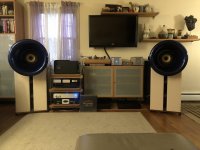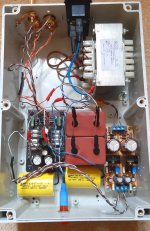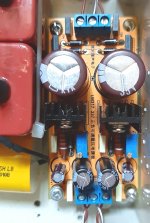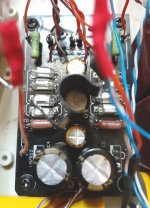Parts advice
Hello All,
First time poster. I’m building a VSPS with premium parts and have two questions-
1st: Is there any reason not to use a Muses-01 opamp instead of an OPA2134? I found a YouTube video showing the same but it is in Japanese...
2nd: Would it be worth using please premium capacitors like V-Cap ODAM’s for C8,C9 (to bypass the voltage regulator electrolytics)? I am going to use these capacitors - which are simply amazing, for C3, and will use them here as well if it is worthwhile:
Thanks in advance for your help,
Aron
Hello All,
First time poster. I’m building a VSPS with premium parts and have two questions-
1st: Is there any reason not to use a Muses-01 opamp instead of an OPA2134? I found a YouTube video showing the same but it is in Japanese...
2nd: Would it be worth using please premium capacitors like V-Cap ODAM’s for C8,C9 (to bypass the voltage regulator electrolytics)? I am going to use these capacitors - which are simply amazing, for C3, and will use them here as well if it is worthwhile:
Thanks in advance for your help,
Aron
1st: Is there any reason not to use a Muses-01 opamp instead of an OPA2134? I found a YouTube video showing the same but it is in Japanese...
2nd: Would it be worth using please premium capacitors like V-Cap ODAM’s for C8,C9 (to bypass the voltage regulator electrolytics)? I am going to use these capacitors - which are simply amazing, for C3, and will use them here as well if it is worthwhile:
1. Muse 01 is a dual, Jfet input op amp broadly comparable to OPA2134. You can use it in the VSPS circuit without further adjustment. Input offset voltage (max) is about 50% worse than the OPA2134, but this shouldn't be a problem unless the device is right on the datasheet worst case.
2. For C3, worth it if you like the caps. For C8,C9 doubtful but this is a "try it and see" thing, no?
I’ve had the VSPS 300 up and running in my system now for several days. I pulled everything off my shelves over the weekend and did some dusting, cleaning and rearranging.
I was happy with what I heard. I am enjoying the system quite a bit lately as I had just finished a pair of F2J monoblocks a few weeks back and have been listening every day.
Having changed the amps so recently has made it difficult to seperate what I am hearing as a result of the amp change or the phono change.
I don’t normally make more than one change at a time because I take quite a long time to build projects. This one just came together quickly since I acquired the VSPS boards populated and used some cases I had bought for power supplies instead of building from scratch as I usually do.
I would like to be able to compare the sound of the VSPS in the system head to head with the JFET phono amp I have been using for a while that is based on a Boozehound Labs kit. It is a derivative of the “Le Pacific” circuit which as I understand it originated with Jean Hiraga.
The VSPS currently produces more noise than the JFET phono. My test was to connect both and turn my system up to the “enthusiastic” listening level, which is almost exactly at the 50% point of my pots of my preamp (depending on the recording). The JFET phono amp is almost completely silent at this level even when listening inside the mouth of my horns.
I can go a little further with the JFET phono before I experience feedback through the system during listening, perhaps to 60%, but I am not interested in hearing distortion or damaging anything in the system. I have not tested what the maximum level the VSPS will go to without feedback or distortion yet.
My idea to compare them is to put a switcher in my system directly after the MC head amp so that I can switch back and forth between the VSPS and the JFET phono amps connected to different inputs on my preamp. Both are set up to produce 40dB of gain.
It will require getting up to change two switches at the same time...less than perfect...perhaps I will get a switching volunteer from the troops currently locked up in the house with me.
I’m not sure this will be a fair comparison without trying to also run the VSPS off of a battery supply.
I was having nothing but problems trying to find a quite power supply for the JFET phono when I first built it. That is why I resorted to using a rechargeable NiMH power supply for it.
My idea is to buy two more 18 or 19.2 V NiMH battery packs to create a bipolar supply for the VSPS. The research I did indicates that if I connect them in series I can then take the positive rail from one pack, the negative from the other and a common from where they are connected in series positive to negative. I’m wondering if this is correct, if others have already done this and what the optimal voltage for the battery packs would be?
Just for reference, my preamp is based on the Salas DCB1 design which I have modified with Jensen transformers on the output to pick up 6dB of gain. There is not a lot of gain in the system when you consider the F2J down stream and the ZYX MC head amp upstream. I am relying on the sensitivity of the DX3s in the horns as well as using 6 high sensitivity drivers in each dipole bass panel which is driven by some bridged Rotel HT amps.
I was happy with what I heard. I am enjoying the system quite a bit lately as I had just finished a pair of F2J monoblocks a few weeks back and have been listening every day.
Having changed the amps so recently has made it difficult to seperate what I am hearing as a result of the amp change or the phono change.
I don’t normally make more than one change at a time because I take quite a long time to build projects. This one just came together quickly since I acquired the VSPS boards populated and used some cases I had bought for power supplies instead of building from scratch as I usually do.
I would like to be able to compare the sound of the VSPS in the system head to head with the JFET phono amp I have been using for a while that is based on a Boozehound Labs kit. It is a derivative of the “Le Pacific” circuit which as I understand it originated with Jean Hiraga.
The VSPS currently produces more noise than the JFET phono. My test was to connect both and turn my system up to the “enthusiastic” listening level, which is almost exactly at the 50% point of my pots of my preamp (depending on the recording). The JFET phono amp is almost completely silent at this level even when listening inside the mouth of my horns.
I can go a little further with the JFET phono before I experience feedback through the system during listening, perhaps to 60%, but I am not interested in hearing distortion or damaging anything in the system. I have not tested what the maximum level the VSPS will go to without feedback or distortion yet.
My idea to compare them is to put a switcher in my system directly after the MC head amp so that I can switch back and forth between the VSPS and the JFET phono amps connected to different inputs on my preamp. Both are set up to produce 40dB of gain.
It will require getting up to change two switches at the same time...less than perfect...perhaps I will get a switching volunteer from the troops currently locked up in the house with me.
I’m not sure this will be a fair comparison without trying to also run the VSPS off of a battery supply.
I was having nothing but problems trying to find a quite power supply for the JFET phono when I first built it. That is why I resorted to using a rechargeable NiMH power supply for it.
My idea is to buy two more 18 or 19.2 V NiMH battery packs to create a bipolar supply for the VSPS. The research I did indicates that if I connect them in series I can then take the positive rail from one pack, the negative from the other and a common from where they are connected in series positive to negative. I’m wondering if this is correct, if others have already done this and what the optimal voltage for the battery packs would be?
Just for reference, my preamp is based on the Salas DCB1 design which I have modified with Jensen transformers on the output to pick up 6dB of gain. There is not a lot of gain in the system when you consider the F2J down stream and the ZYX MC head amp upstream. I am relying on the sensitivity of the DX3s in the horns as well as using 6 high sensitivity drivers in each dipole bass panel which is driven by some bridged Rotel HT amps.
Attachments
Thanks for the detailed report.
Some years ago I experimented with a JFET phono stage, a two stage passive RIAA circuit similar to .. well most of the other ones out there, including Le Pacific. I dropped it because for MC gains it was impractical, but I did appreciate that the single JFET input is less noisy than the OPA27 op amp used in the Emerald and Phonoclone. It shouldn't be a practical concern though, even in a sensitive horn system such as yours. If it is the noise may be above normal for some reason.
Some years ago I experimented with a JFET phono stage, a two stage passive RIAA circuit similar to .. well most of the other ones out there, including Le Pacific. I dropped it because for MC gains it was impractical, but I did appreciate that the single JFET input is less noisy than the OPA27 op amp used in the Emerald and Phonoclone. It shouldn't be a practical concern though, even in a sensitive horn system such as yours. If it is the noise may be above normal for some reason.
4/25 Update re. orders and the postal situation.
Several orders are backed up recently, for which I apologize. It's a combination of multiple factors:
US, UK, Canada, New Zealand, France, and Germany are sill accepting mail.
Australia, most of the rest of Europe, Russia, and lots of smaller countries are not.
All delayed orders should get shipped next week, except for those to destinations I am unable to ship to.
Thanks for your understanding,
Richard
Several orders are backed up recently, for which I apologize. It's a combination of multiple factors:
- I ran out of some parts which I re-ordered from Mouser.
- I ran out of Emerald boards which I re-ordered but shipped to the wrong address, so they go delayed.
- Due to Coronavirus, many countries are no longer accepting international mail.
- Due to Coronavirus, many people have extra time and want to build diyaudio, so I have more orders than usual to fufill.
US, UK, Canada, New Zealand, France, and Germany are sill accepting mail.
Australia, most of the rest of Europe, Russia, and lots of smaller countries are not.
All delayed orders should get shipped next week, except for those to destinations I am unable to ship to.
Thanks for your understanding,
Richard
Hi Richard
Thanks for your feedback.
I read through your notes regarding your JFET phono construction again.
After reading your comments:
“...jfet and tube versions are actually much harder to pull off. The simplicity of the circuit is misleading. In essence it's just passing the buck over to the power supply. Whereas most circuits are designed to block power supply noise from the output, this circuit actually amplifies power supply noise into the output signal. The power supply must therefore be exceptionally low noise.”
I was left with the question “Is there any relevant gains concerning noise reduction to be had by switching an Op Amp based design over to a battery power supply?”
Thanks for your feedback.
I read through your notes regarding your JFET phono construction again.
After reading your comments:
“...jfet and tube versions are actually much harder to pull off. The simplicity of the circuit is misleading. In essence it's just passing the buck over to the power supply. Whereas most circuits are designed to block power supply noise from the output, this circuit actually amplifies power supply noise into the output signal. The power supply must therefore be exceptionally low noise.”
I was left with the question “Is there any relevant gains concerning noise reduction to be had by switching an Op Amp based design over to a battery power supply?”
“Is there any relevant gains concerning noise reduction to be had by switching an Op Amp based design over to a battery power supply?”
Op amps have very high PSRR, at least for low frequencies. So paired with a reasonably effective, low noise voltage regulator, the baseline output noise should be the self-noise of the op amp, not the power supply ripple/noise.
So my answer is "no, not if you do it right.".
Hi Richard
I value your feedback. Thanks for sharing your experience. I apologize if it is stuff you’ve already said a thousand times.
I am currently just listening. Putting together this VSPS quickly was a way for me to try and experience an op amp based phono for myself and make a judgement as to whether I would want to go further and possibly pursue building a Phonoclone or Emerald.
I was trying to figure out what can be optimized to get the best experience from these designs.
I think I pretty much followed your power supply recommendations. The only difference was using the Daniels board with U860 diodes and the small 100Uf caps on the output as opposed to just chassis mount GBPC bridge rectifiers.
I value your feedback. Thanks for sharing your experience. I apologize if it is stuff you’ve already said a thousand times.
I am currently just listening. Putting together this VSPS quickly was a way for me to try and experience an op amp based phono for myself and make a judgement as to whether I would want to go further and possibly pursue building a Phonoclone or Emerald.
I was trying to figure out what can be optimized to get the best experience from these designs.
I think I pretty much followed your power supply recommendations. The only difference was using the Daniels board with U860 diodes and the small 100Uf caps on the output as opposed to just chassis mount GBPC bridge rectifiers.
Hello there,
I 've been using a dual regulated power supply board based on LM317/337.
It's available as a kit if someone wants an adjustable supply.
The result is zero noise and a range of supply voltages.
Right now I've been using an LME49720HA opamp (metal can package).
IT is very detailed and i am happy with it.
It can be too prescise and maybe a bit on 'dry' at times.
Especially if you are coming from an OPA2134.
Muses01 is certainly smoother but it's a lot more expensive.
Muses8820 is a good choice being more warm and I think it is better value that Muse01.
An overall improvement was achieved by changing the WIMA RIAA capacitors to XICON polysterene.
Also, further improvement was achieved by replacing the TDK ceramic bypass capacitors with XICON polysterenes. The improvement was more evident when I using the LME49720HA opamp. Maybe it's more sensitive to bypassing.
Overall I am very pleased with this RJM's product and his support!
I 've been using a dual regulated power supply board based on LM317/337.
It's available as a kit if someone wants an adjustable supply.
The result is zero noise and a range of supply voltages.
Right now I've been using an LME49720HA opamp (metal can package).
IT is very detailed and i am happy with it.
It can be too prescise and maybe a bit on 'dry' at times.
Especially if you are coming from an OPA2134.
Muses01 is certainly smoother but it's a lot more expensive.
Muses8820 is a good choice being more warm and I think it is better value that Muse01.
An overall improvement was achieved by changing the WIMA RIAA capacitors to XICON polysterene.
Also, further improvement was achieved by replacing the TDK ceramic bypass capacitors with XICON polysterenes. The improvement was more evident when I using the LME49720HA opamp. Maybe it's more sensitive to bypassing.
Overall I am very pleased with this RJM's product and his support!
Here are some pictures of the project as of lately.
The XICON styroflex capacitors are in parallel with the electrolytics but are not visible because they are under the board due to space.
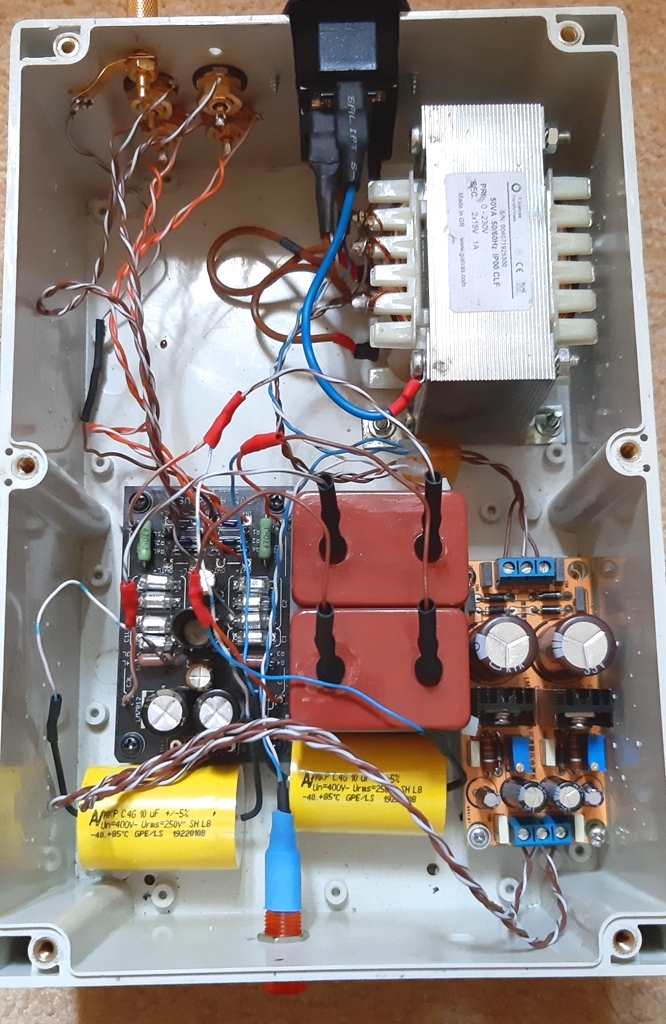
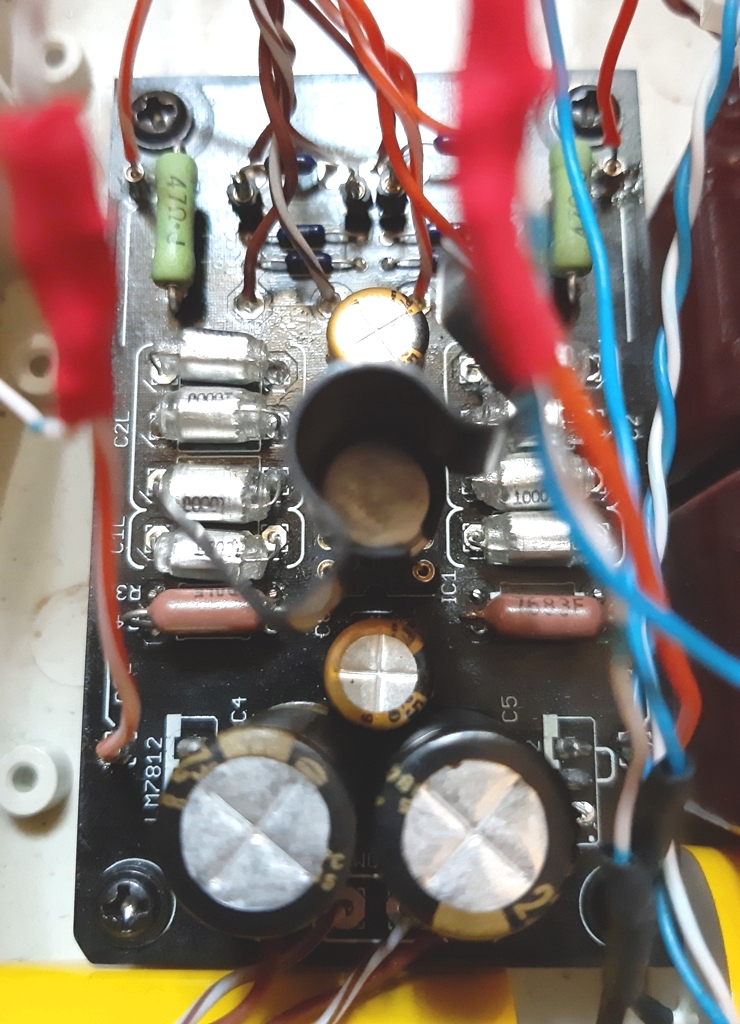

The XICON styroflex capacitors are in parallel with the electrolytics but are not visible because they are under the board due to space.
Attachments
Last edited:
If anyone is interested I can prepare a recording and share it.
It will give you an idea of what this little kit is capable.
If you've got any particular song in mind say so.
Might use a common cartridge like an AT VM95C, an AT3600L etc, that many people are familiar with.
It will give you an idea of what this little kit is capable.
If you've got any particular song in mind say so.
Might use a common cartridge like an AT VM95C, an AT3600L etc, that many people are familiar with.
Hi Richard,
I have a Phonoclone 3 rev 35h and was wondering if it is possible to bring it up to the latest Phonoclone 4 stage or would that need a different board? I particularly note your comments on a much earlier post about the X reg vs S reg.
Sorry if this has been discussed before.
Mike
I have a Phonoclone 3 rev 35h and was wondering if it is possible to bring it up to the latest Phonoclone 4 stage or would that need a different board? I particularly note your comments on a much earlier post about the X reg vs S reg.
Sorry if this has been discussed before.
Mike
@woodturner-fran
Well well, that's someone I haven't from in a while! Hi Fran, how are you doing?
Op amps in the VSPS will do just fine on anything from 8-15 V rails, 9-12 V being ideal.
@mickhick1
Yes, new board and a small difference in mounting holes I'm afraid. You can re-use the op amps and the output coupling caps. It's not quite a drop-in replacement, but rather a couple of 3mm drill holes away from it.
Richard
Well well, that's someone I haven't from in a while! Hi Fran, how are you doing?
Op amps in the VSPS will do just fine on anything from 8-15 V rails, 9-12 V being ideal.
@mickhick1
Yes, new board and a small difference in mounting holes I'm afraid. You can re-use the op amps and the output coupling caps. It's not quite a drop-in replacement, but rather a couple of 3mm drill holes away from it.
Richard
@woodturner-fran
Well well, that's someone I haven't from in a while! Hi Fran, how are you doing?
Op amps in the VSPS will do just fine on anything from 8-15 V rails, 9-12 V being ideal.
Richard
Thanks!! Life is good, away from DIY audio for a while but doing some tidying up in pandemic times!
Hope you are doing well too!!
G'day all, just a question without notice. Years ago I did build a basic VSPS and rather liked it, but the rising frequency response above 20 khz rather unnerved me! Is there a way to add simple filter on the output to roll off the response and maintain close adherence to the spirit of the original RIAA phono playback specification? Regards, Felix.
Last edited:
- Home
- Source & Line
- Analogue Source
- The Phonoclone and VSPS PCB Help Desk
